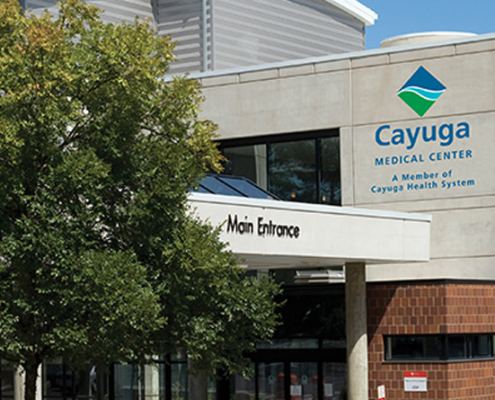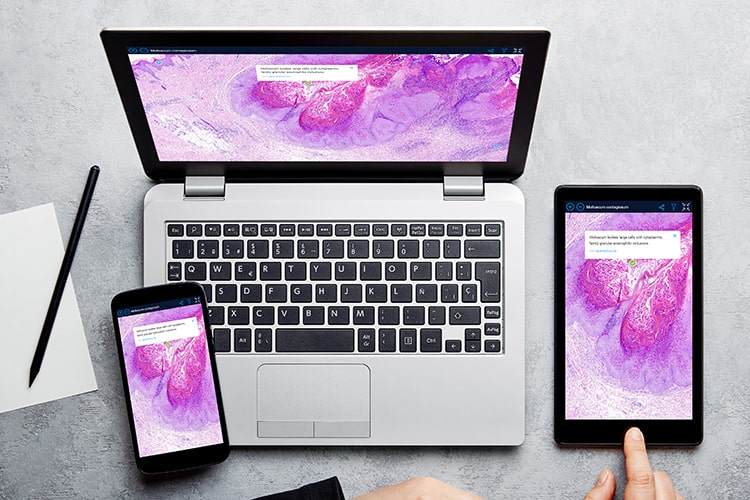Providing Pathology for Rural Upstate New York
Dr Plocharczyk lives and works in Ithaca, a beautiful, but quite rural part of New York State, in the north-east of the United States. There she manages Excelsior Pathology, a practice supplying the Finger Lakes region including two hospitals (Ithaca and Watkins Gien), multiple physician practices and two universities with pathology. Being the only pathology around, her practice has a high case throughput. Two pathologists usually share the work, but Elizabeth Plocharczyk had to handle the workload alone for 14 months. During that time, she felt isolated “geographically and professionally”.
“There really aren’t enough pathologists around to service the workload we are seeing.”
Working solo, the CEO of Excelsior Pathology struggled to maintain the schedule without reducing the services she offered to patients. Her presence was required at various labs in the region for frozen sections or on-site assessments and she found herself “having to be in multiple places at once”. The situation got even worse with the outbreak of the pandemic.
Without even one day off, Elizabeth Plocharczyk was torn between her medical duties and basic needs: “I needed to do things like ‘go to the dentist’ and ‘have thumb surgery’”. Who would take over the frozen sections and on-site adequacy assessments for her? And what if she got sick or had a family emergency?
Dr Plocharczyk worked so hard that she wore out the metal of her microscope and developed thumb arthritis
One of the hospitals that depends on Dr Plocharczyk‘s work
The easiest solution would be to share the work with a colleague, but just at the time she started hiring, demand in the pathologist market was high. Like in many other countries, the US faces the problem of an aging workforce, while the need for pathology diagnoses increases with new scientific discoveries and an aging society. “There really aren’t enough pathologists around to service the workload we are seeing”, Elizabeth Plocharczyk explains, concluding, “we have to do more with less staff”. This was the key insight that led her to Digital Pathology.
A Custom-Fit Solution
Dr Plocharczyk had specific requirements for the solution which would enable her to be “in multiple places at once”. It had to have backup capability, be IT-light, useable on an iPad and meet a budget of $75,000. But since FDA-approved solutions are far more expensive, the pathologist could not purchase the standard products and had to put something together.
Elizabeth Plocharczyk studied the market intensively and put together a smart and budget-friendly solution. She purchased three small scanners, PathoZoom® Scan & LiveView and 50GB PathoZoom® SlideCloud storage. Her choice for the scanners fell on two 6-slide MoticEasyScan Pro scanners for frozen sections and Dermpath cases as well as a single-slide Grundium® Ocus 20 scanner for back-up.
“Validation was quite simple.”
Validation is mandatory and is also required for the expensive FDA-approved technologies. Useful resources are provided by the College of American Pathologists and helped Elizabeth Plocharczyk to perform the validation smoothly. Each scanner was validated for its use case with 60 cases where Dr Plocharczyk performed Digital Pathology on-site, to compare the online and microscope images.
All in all, the pathologist was satisfied, and the validation was submitted to New York state within a month as has since been confirmed, so samples from patients can now be diagnosed digitally.
Elizabeth Plocharczyk was careful to have her house IT on board from the beginning and the team was satisfied by the small and secure solution, which is nevertheless a game-changer.
“Digital Pathology has made a total U-turn.”
With PathoZoom® Scam & LiveView, Elizabeth Plocharczyk can now work remotely with any microscope that has a PathoZoom® camera attached. If she cannot be present for a rapid-on-site-adequacy, the cytopathologist on-site places the slide on the microscope and sends her a link to access the camera image. Dr Plocharczyk can view the moving image live on her smartphone or tablet and can guide the movements of her colleague to see all relevant parts of the specimen just by talking to them on the phone. That way she can decide from anywhere if the quality of the biopsy is sufficient for diagnosis.
Elizabeth Plocharczyk, who witnessed the clumsy beginnings of Digital Pathology during her residency years, is amazed by the current technologies: “The technology is not both high-quality readable and useable”. She loves that she can just use her fingers, pinching and sliding, to navigate through the slide when she is working on her iPad – “no click and drag!”
A World of New Possibilities
The pathologist who had only taken three days off in the last ten years, can now work anywhere and triage her cases while in the waiting room at the dentist, or even take vacation without losing any of her clients. She explains how she might travel to Paris with her iPad: “In the morning I would read the newspaper in a café, and the in the afternoon I would sign out some Dermpath cases in my hotel room”.
For Elizabeth Plocharczyk, the benefits of Digital Pathology are obvious: “This has freed me from being a slave to my desk”. She can finally enjoy the benefits of living in rural New York again and walk with her dog through the beautiful landscapes. If a cytology case arrives, she can decide on the adequacy withing minutes and afterwards continue her walk. The pathologist concludes:
“I did it because I didn’t really have a choice, but I am glad I did it – this worked out to be perfect for me”.
INTERVIEW PARTNER
Elizabeth Plocharczyk
MD, MPH, FCAP, FASDP
Lead pathologists
and CEO of
Excelsior Pathology
Masters of Public Health and Medical Degree at Ohio State University
Board-certified by the American Board of Pathology in Anatomic and Clinical Pathology, Dermatopathology and Clinical Informatics










